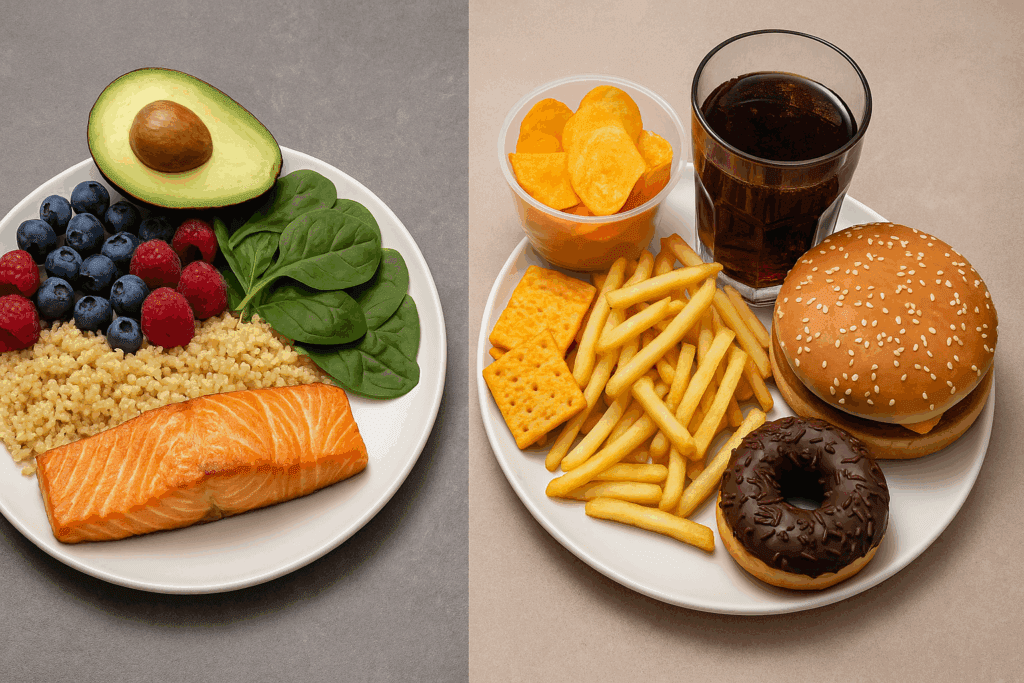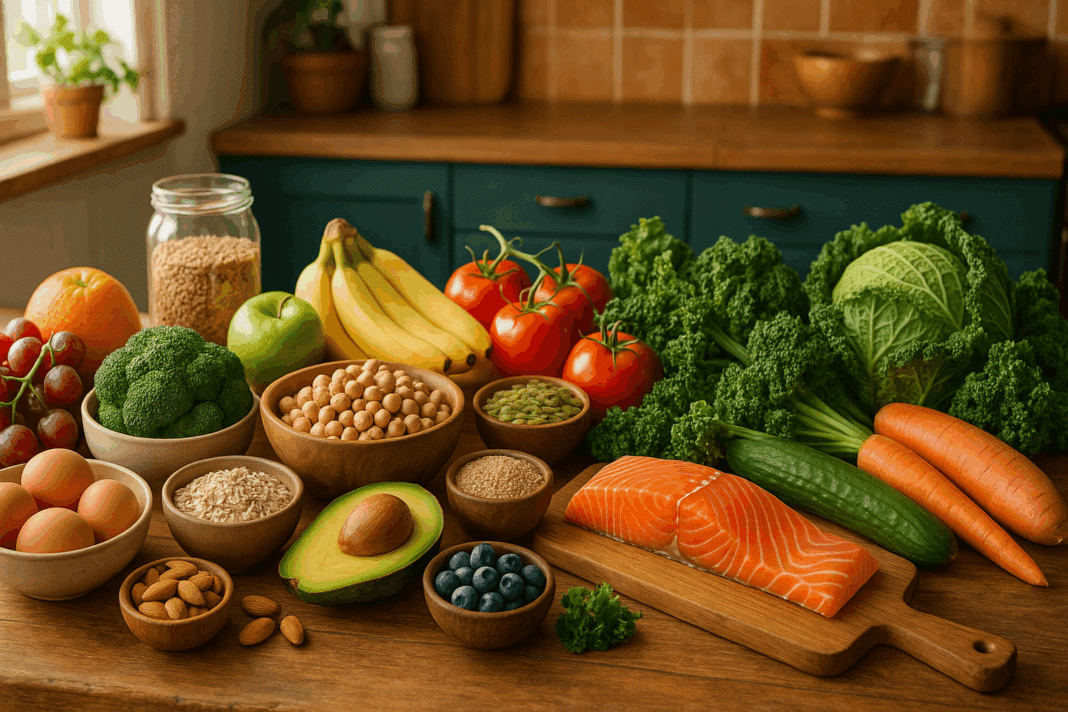Rediscovering the Power of Whole Foods in a Processed World
In today’s fast-paced culture, convenience often takes priority over nourishment. Ultra-processed meals, frozen entrees, and sugar-laden snacks dominate grocery aisles, leaving many wondering what happened to real food. Amid this modern food confusion, the term “whole foods” frequently surfaces in conversations around health and wellness. But to genuinely understand what whole foods mean, it’s important to look beyond marketing labels and dive into the roots of whole food nutrition. Doing so reveals a lifestyle approach that honors the body’s natural needs and offers a powerful counterbalance to the synthetic nature of today’s typical diet.
Whole food nutrition demystified is more than just an academic exercise—it is a blueprint for reclaiming vitality, energy, and long-term health. Unlike restrictive diets that focus on cutting calories or entire food groups, eating whole foods encourages inclusion. It’s about abundance rather than avoidance—an invitation to embrace nourishing foods in their most authentic form. Understanding the whole foods definition can help individuals navigate nutrition with clarity, while the benefits of whole foods speak volumes for disease prevention, sustained energy, and improved mental clarity. When we prioritize whole food choices, we align our eating habits with evolutionary wisdom and emerging science.
By exploring whole food nutrition demystified, we begin to reconnect with nature’s original design for healthful eating. Instead of trusting slogans on packages, we return to trusting the food itself. In this article, we will clarify the whole foods meaning, explore whole food diet benefits, and illustrate why the whole foods nutritional value is superior to processed counterparts. Whether you’re new to clean eating or seeking to refine your approach, understanding the benefits of eating whole foods is key to making confident, mindful choices every day.
You may also like: How a Whole Foods Diet Supports Sustainable Weight Loss: Expert Tips for Eating Whole Foods to Lose Weight Safely

Defining Whole Foods: What It Really Means to Eat Naturally
At its core, the whole foods definition refers to foods that are minimally processed, unrefined, and as close as possible to their natural state. This includes a wide range of plant and animal-based foods—think fresh fruits and vegetables, whole grains, legumes, nuts, seeds, eggs, and unprocessed meats. What distinguishes these items is their nutritional integrity. Whole foods are rich in naturally occurring fiber, vitamins, minerals, and antioxidants, all of which are often lost or degraded during commercial processing.
When asking what whole foods mean, it’s important to understand that it goes beyond food that is merely organic or labeled as “natural.” Whole foods are not just about what they are, but also about what they aren’t. They are free from artificial preservatives, colorings, flavorings, and emulsifiers commonly added to processed foods. For example, a baked sweet potato is a whole food, while a sweet potato chip seasoned with artificial flavor enhancers is not. The simplicity of the whole food definition makes it easier to evaluate the quality of the food we eat based on how close it remains to its original form.
This approach emphasizes the synergy of nutrients in food. Unlike supplements or isolated compounds, whole foods offer a complete nutritional profile where each component supports the others. The fiber in an apple helps regulate blood sugar, while the vitamin C aids in iron absorption. When nutrients are consumed together in their natural matrix, they often function more effectively than they do when taken individually. This is one of the key reasons why whole food nutrition is demystified is critical in today’s health discourse.

The Nutritional Value of Whole Foods: A Closer Look at What You Gain
One of the most compelling arguments for choosing whole foods is the sheer nutritional value they offer. Whole foods nutritional value is significantly higher than that of processed alternatives because they retain their complete fiber content, essential fatty acids, phytonutrients, and trace minerals. A bowl of steel-cut oats, for instance, contains more fiber, magnesium, and plant-based protein than most boxed breakfast cereals, even those labeled as “healthy.” It also lacks the added sugars and chemical preservatives found in many packaged foods.
The benefits of eating whole foods extend to nearly every system in the body. The digestive system thrives on dietary fiber, which is found in abundance in vegetables, legumes, and whole grains. Fiber not only supports regular bowel movements but also feeds beneficial gut bacteria that play a role in immunity and mental health. These complex carbohydrates digest slowly, keeping blood sugar levels stable and preventing the energy crashes that follow highly refined meals.
Additionally, many whole foods are rich in anti-inflammatory compounds. Berries, leafy greens, and fatty fish like salmon contain polyphenols and omega-3s that help reduce chronic inflammation—an underlying factor in heart disease, diabetes, and cancer. The whole food’s meaning, in this context, becomes synonymous with functional nourishment: food that does more than just prevent hunger—it actively supports healing and long-term vitality.
Beyond the physical, whole foods also impact mental and emotional well-being. Nutrient-dense options like walnuts, pumpkin seeds, and bananas help regulate neurotransmitters that influence mood. When the body receives optimal nutrition through whole food sources, mental clarity and emotional balance often improve. These far-reaching benefits of whole foods make them an essential foundation for a healthier lifestyle at any age.

Disease Prevention and Healing Through Whole Food Nutrition
Perhaps one of the most impactful reasons to embrace whole food nutrition demystified is its role in preventing and managing chronic illness. Scientific studies have consistently shown that diets rich in whole foods are associated with lower risks of heart disease, obesity, metabolic syndrome, and even certain cancers. The whole food diet benefits go beyond symptom relief—they offer a proactive way to reverse or halt disease progression by addressing root causes.
Whole plant-based diets, in particular, have been found to improve cholesterol levels, reduce blood pressure, and enhance insulin sensitivity. This is especially relevant in the context of type 2 diabetes, where managing blood sugar through diet is crucial. Legumes, leafy greens, whole grains, and berries help reduce post-meal glucose spikes and support steady insulin function. The benefits of whole foods in managing diabetes are well-documented and continue to shape modern dietary interventions.
Heart health is another area where the whole foods definition holds significant clinical relevance. Diets high in fiber, potassium, and antioxidants—all abundant in whole foods—help reduce arterial plaque, improve circulation, and lower LDL cholesterol levels. Physicians practicing lifestyle medicine often recommend whole foods as a first-line intervention for hypertension and early-stage cardiovascular conditions, citing improvements that rival those of medications in some cases.
Whole food nutrition also supports the body’s natural detoxification systems. The liver, kidneys, and lymphatic system all rely on nutrients like glutathione, vitamin C, and magnesium to function effectively—nutrients that are most bioavailable in unprocessed, natural foods. Unlike marketed “cleanses” or “detox teas,” eating a diet based on whole foods truly supports detoxification through scientifically grounded means.

How to Transition to a Whole Foods-Based Lifestyle
Making the switch to whole foods doesn’t require a complete overhaul overnight. Rather, it involves making consistent, thoughtful choices that prioritize simplicity, freshness, and transparency. One of the most accessible ways to begin is by shopping the perimeter of grocery stores where fresh produce, bulk grains, and unprocessed proteins are typically located. Avoiding the middle aisles—where packaged, shelf-stable items dominate—can reduce exposure to highly processed foods.
Meal planning plays a vital role in sustaining this transition. Preparing meals from scratch using whole ingredients may initially seem time-consuming, but batch cooking, using a slow cooker, or preparing ingredients in advance can streamline the process. Focus on building meals around whole grains, legumes, vegetables, and healthy fats, adding lean proteins or plant-based alternatives as needed. Understanding the whole foods definition can help guide these decisions in a practical, sustainable way.
Restaurants and take-out can still fit into a whole food lifestyle with mindful choices. Opting for dishes that feature grilled vegetables, whole grains, or unbreaded proteins without heavy sauces can help maintain whole food principles while eating out. Asking for dressings and toppings on the side or choosing dishes with recognizable ingredients are small strategies that make a big impact.
A whole food lifestyle also means developing a better relationship with food. Cooking at home, involving family members in meal prep, and experimenting with new flavors and textures can all reignite joy in eating. As you begin to feel the benefits of eating whole foods—better energy, improved digestion, mental clarity—you’ll likely find motivation to continue and expand on your efforts.

The Broader Impact: Sustainability, Food Ethics, and Community Health
Choosing whole foods doesn’t just benefit your body—it also supports broader values of environmental sustainability and ethical food production. Whole plant foods, in particular, have a lower ecological footprint than meat-heavy or packaged diets. They require fewer resources, generate less waste, and often come with minimal packaging. The more people shift toward whole food diets, the greater the collective impact on reducing carbon emissions and supporting biodiversity.
Many whole foods can be sourced locally, which reduces the environmental costs of transportation and supports regional farmers. Community-supported agriculture (CSA) programs, farmers’ markets, and local co-ops make it easier to access seasonal produce and sustainably raised animal products. By supporting these food systems, consumers play an active role in shaping a healthier, more equitable food landscape.
Whole food nutrition demystified also has implications for public health. In communities where processed food dominates and diet-related diseases are common, increasing access to whole foods can reduce health disparities and improve outcomes. School lunch programs, food banks, and urban farming initiatives are now incorporating whole food principles to combat obesity and malnutrition in underserved populations.
In this way, understanding what whole foods mean becomes part of a larger conversation about food justice, climate resilience, and long-term societal well-being. It’s not just a personal health choice—it’s a community-wide investment in a better future.
Frequently Asked Questions (FAQ): Whole Food Nutrition Demystified
1. How does understanding the whole foods definition help improve long-term dietary habits?
Grasping the full scope of the whole foods definition allows individuals to distinguish between marketing hype and genuine nutrition. Many foods are advertised as “natural” or “healthy,” but unless they meet the criteria that define whole foods—minimal processing, no synthetic additives, and complete nutrient integrity—they may not offer the same health benefits. When people learn to identify true wholefood meaning, they become more selective, prioritizing quality over convenience. This knowledge supports long-term health goals by fostering dietary consistency, minimizing empty calories, and reducing exposure to additives that may disrupt metabolic or gut health. Over time, understanding the whole foods def can transform not only food choices but also overall lifestyle awareness and cooking habits.
2. What is the relationship between whole food nutrition and mental health?
Emerging research highlights a strong link between whole food nutrition and psychological well-being. Whole foods rich in omega-3 fatty acids, B vitamins, and antioxidants support brain function, neurotransmitter production, and stress regulation. Diets built on whole foods nutritional value may reduce the risk of anxiety and depression, especially when compared to ultra-processed diets high in sugar and trans fats. In this context, the benefits of eating whole foods extend beyond physical wellness, supporting emotional resilience and cognitive clarity. Understanding what does whole foods mean in mental health settings opens the door to nutrition-based strategies in managing mood and supporting recovery from burnout or chronic stress.
3. How does whole food nutrition impact children’s growth and development?
Whole food nutrition plays a crucial role in the healthy development of children, influencing everything from bone growth to immune function. The whole foods nutritional value in foods like leafy greens, legumes, berries, and whole grains ensures adequate intake of key nutrients like iron, zinc, and vitamin A. These nutrients are essential for cognitive development, physical growth, and hormonal balance throughout childhood and adolescence. By introducing children early to the benefits of eating whole foods, parents can help establish lifelong preferences for unprocessed, nutrient-dense meals. Teaching kids the whole foods meaning through hands-on cooking or gardening also empowers them to make smarter food choices as they mature.
4. Can you define whole foods within the context of athletic performance and recovery?
To define whole foods in the realm of athletic performance is to highlight their role in sustained energy, muscle repair, and inflammation control. Whole foods like quinoa, sweet potatoes, nuts, and dark leafy greens offer a superior ratio of carbohydrates, protein, and micronutrients compared to refined alternatives. The benefits of whole foods become especially evident post-workout, when antioxidants and amino acids from whole food sources aid in muscle recovery and reduce oxidative stress. Athletes who understand the wholefood meaning often experience enhanced endurance and fewer digestive issues due to the absence of preservatives and synthetic enhancers in their diets. Integrating whole food nutrition into pre- and post-workout meals is a performance-enhancing strategy rooted in natural science.
5. How do socioeconomic factors influence access to whole foods?
While the whole foods definition emphasizes freshness and minimal processing, accessibility can be limited by geographic and economic constraints. In food deserts or low-income areas, grocery stores often lack fresh produce and whole grains, making processed foods the more affordable and available option. However, understanding the benefits of whole foods doesn’t have to remain an elitist concept. Programs like community gardens, co-ops, and urban farms are helping to bridge the gap by redefining what whole foods mean in underserved communities. Empowering people with budget-friendly strategies for sourcing and preparing whole foods—like buying in bulk or choosing seasonal produce—can significantly enhance food equity.
6. How does food marketing distort the whole foods meaning?
Marketing campaigns frequently misuse terms associated with health to promote products that do not meet the true whole foods definition. Phrases like “clean,” “natural,” or “wholesome” are often used on processed foods with added sugars, preservatives, and artificial flavors. This manipulation dilutes consumer understanding of whole food nutrition and creates confusion around what truly constitutes a healthy option. Educated consumers who understand the benefits of whole foods learn to read labels critically and question vague health claims. Clarifying the wholefood meaning helps people make decisions based on ingredient quality, not just front-of-package slogans or trendy buzzwords.
7. Are there specific cooking methods that preserve whole foods nutritional value?
Yes, certain cooking techniques are better suited to preserving the nutrients in whole foods. Steaming, roasting, and light sautéing generally retain more vitamins and minerals than boiling or deep-frying. For example, steaming broccoli helps preserve its vitamin C content, while lightly sautéing greens in olive oil enhances the absorption of fat-soluble nutrients like vitamin K and carotenoids. Understanding the whole foods def involves not only selecting whole ingredients but also preparing them in ways that maintain their integrity. Additionally, slow cooking and fermenting are methods that align with whole food nutrition principles by enhancing digestibility and bioavailability of certain compounds.
8. What are some cultural perspectives that align with the whole food diet benefits?
Many traditional cuisines around the world naturally reflect the principles of whole food nutrition. Mediterranean, Japanese, Ethiopian, and many Indigenous diets emphasize whole grains, legumes, fermented foods, fresh vegetables, and modest portions of animal products. These dietary traditions highlight the benefits of eating whole foods as part of a cultural lifestyle rather than a modern diet trend. Exploring these ancestral foodways can deepen our appreciation for the whole foods meaning and encourage a more diverse, inclusive approach to health. Recognizing cultural diversity in whole food choices also helps dismantle the idea that wholefood meaning applies only to Western nutrition models.
9. How does whole food nutrition align with environmental sustainability?
Whole food nutrition and environmental sustainability often go hand in hand. Producing whole plant-based foods typically requires fewer resources—such as water, land, and fossil fuels—than the production of processed or heavily packaged foods. The benefits of whole foods extend beyond human health to planetary health, especially when foods are sourced locally and seasonally. Understanding what does whole foods mean in an environmental context encourages consumers to consider their impact on ecosystems, carbon emissions, and biodiversity. Composting food scraps, supporting farmers’ markets, and choosing unpackaged whole items are all ways to reinforce the environmental side of the whole foods def.
10. What does the future of whole food nutrition look like in healthcare?
As the healthcare industry increasingly adopts a preventive care model, whole food nutrition is becoming a cornerstone of clinical recommendations. Some hospitals and clinics now include culinary medicine programs where patients are taught to cook whole foods for disease management. This reflects a shift in how professionals define whole foods—not merely as dietary choices but as therapeutic tools. With growing research supporting the whole food diet benefits in reducing hospital readmissions and improving quality of life, policy changes may soon prioritize whole food access in public health initiatives. Ultimately, understanding the benefits of whole foods could become as central to medical care as medications themselves, signaling a new era in integrative health.

Conclusion: Why Embracing the Whole Foods Meaning Is a Path to Lasting Wellness
In a world where health messages are often confusing and contradictory, whole food nutrition demystified offers a refreshingly simple, evidence-based approach to wellness. By asking what does whole foods mean and exploring its practical implications, we unlock the potential for a healthier, more conscious lifestyle rooted in nourishment, balance, and integrity. Whole food nutrition isn’t about perfection—it’s about intention. It’s about making choices that prioritize the body’s needs, support the planet’s resources, and align with our values.
The benefits of eating whole foods go far beyond their nutritional profiles. They nourish the microbiome, stabilize blood sugar, reduce inflammation, support emotional balance, and enhance the overall experience of eating. The whole food diet benefits extend from the cellular level to the community level, touching every aspect of life with greater vitality and resilience.
As more people explore the whole foods’ meaning and commit to a diet centered on whole ingredients, the ripple effects are profound. From improved personal health to reduced environmental impact, the case for whole food nutrition becomes undeniable. What was once considered a traditional way of eating now emerges as a modern solution to today’s most pressing health challenges.
So whether you’re just beginning or refining your journey, embracing whole food nutrition is one of the most powerful steps you can take toward a healthier lifestyle—one rooted in simplicity, science, and sustainability.
Was this article helpful? Don’t let it stop with you. Share it right now with someone who needs to see it—whether it’s a friend, a colleague, or your whole network. And if staying ahead on this topic matters to you, subscribe to this publication for the most up-to-date information. You’ll get the latest insights delivered straight to you—no searching, no missing out.
Further Reading:
Whole-Foods Diet 101: A Complete Beginner’s Guide
Disclaimer
The information contained in this article is provided for general informational purposes only and is not intended to serve as medical, legal, or professional advice. While NewsHealthWatch strives to present accurate, up-to-date, and reliable content, no warranty or guarantee, expressed or implied, is made regarding the completeness, accuracy, or adequacy of the information provided. Readers are strongly advised to seek the guidance of a qualified healthcare provider or other relevant professionals before acting on any information contained in this article. NewsHealthWatch, its authors, editors, and contributors expressly disclaim any liability for any damages, losses, or consequences arising directly or indirectly from the use, interpretation, or reliance on any information presented herein. The views and opinions expressed in this article are those of the author(s) and do not necessarily reflect the official policies or positions of NewsHealthWatch.

